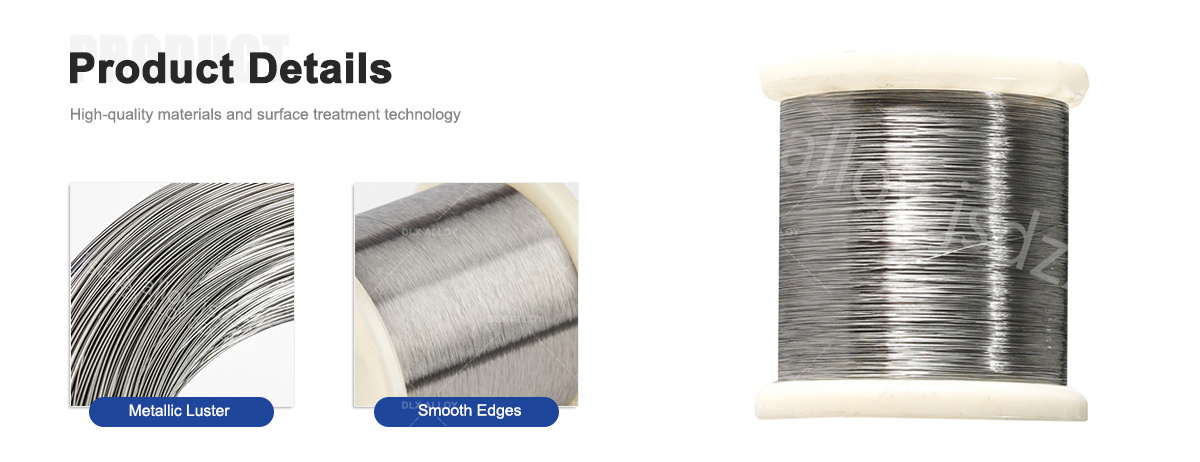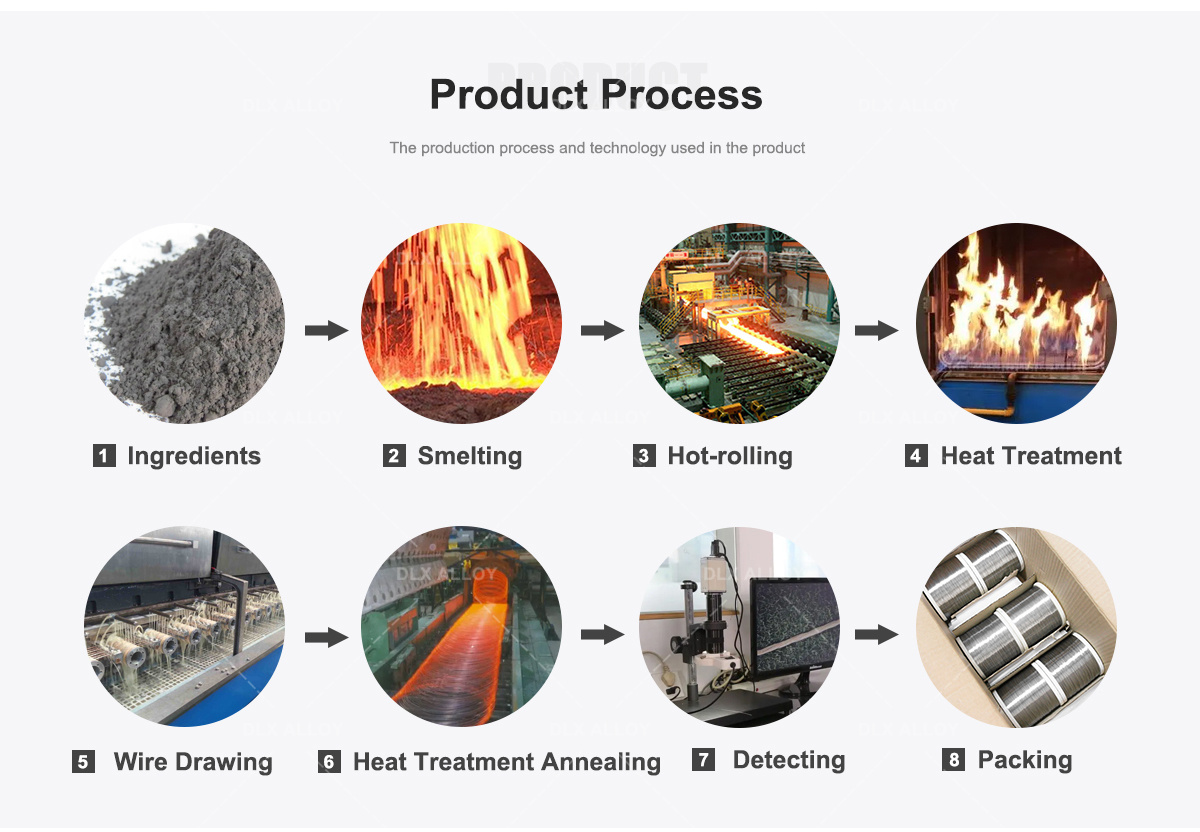 0
0
Products Description

Monel wire is a high-performance nickel-copper alloy wire widely used in the oil and gas industry. It has excellent corrosion resistance, high temperature performance and mechanical properties to handle harsh working environments. Monel wire can resist the erosion of acidic, alkaline and salty media, including acidic oil well fluids, high salinity water and hydrogen sulfide. Under high temperature and high pressure conditions, Monel wire can maintain stable performance without being affected. Therefore, it is widely used in the manufacture of key components of oil and gas industry equipment, such as pipes, valves, and furnace tubes.
Parameter

Item | Ni | Cu | Fe | Mn | C | Si | S |
Monel 400 | ≥63 | 28-34 | ≤2.5 | ≤2 | ≤0.3 | ≤0.5 | ≤0.025 |
Item | Ni | Cu | Al | Ti | Fe | Mn | S | C | Si |
Monel K500 | ≥63 | 27-33 | 2.3-3.15 | 0.35-0.85 | ≤2 | ≤1.5 | ≤0.01 | ≤0.25 | ≤0.5 |
Item | Density | Melting point | Tensile Strength | Yield Strength | Elongation | HB |
Monel 400 | 8.83 g/cm3 | 1300-1390℃ | 480 | 170 | 35% | ≥331 |
Item | Density | Melting point | Tensile Strength | Yield Strength | Elongation |
Monel K500 | 8.05 g/cm3 | 1288-1343℃ | 1100 | 790 | 20% |
Monel 400 | Bar / Rod | Forging | Pipe | Sheet / Strip | Welding Wire |
Standard | ASTM B164 | ASTM B564 | ASTM B165 | ASTM B127 | ErNiCu-7 |
Monel K500 | Bar/Rod | Forging | Pipe | Sheet/Strip | Welding Wire |
Standard | ASTM B864 | AMS4676 | ASTM B865 | ASTM B564 | ErNiCu-7 |
For more details, pls directly contact us.

Production process

The production process of Monel silk includes the following steps:
Raw material preparation: The first step in producing Monel silk is to prepare raw materials. Nickel, copper and other alloying elements are usually used as raw materials. These raw materials need to undergo rigorous chemical analysis and screening to ensure that their quality and composition meet requirements.
Smelting and alloying: During the smelting process, the raw materials prepared in advance are put into the furnace for melting. According to the required alloy composition of Monel wire, appropriate amounts of nickel, copper and other alloying elements are added to the furnace to perform alloying reactions to obtain the required chemical composition.
Continuous casting: After the alloy is melted, the molten alloy is injected into a continuous casting machine through continuous casting technology. In a continuous casting machine, the molten alloy is gradually formed into a continuous ingot or billet through a uniform cooling and solidification process.
Hot rolling and cold rolling: The ingot or billet after continuous casting needs to be pressed and processed through hot rolling and cold rolling processes. First, the ingot or billet is heated to the appropriate temperature by hot rolling, and then pressed into the desired shape and size through a rolling mill. Next, the hot-rolled material is further pressed and processed through cold rolling to obtain a finer diameter and higher surface quality.
Annealing treatment: During the cold rolling process, Monel wire will produce certain strain and internal stress. In order to relieve these stresses and improve the mechanical properties of the material, annealing is required. The annealing process involves heating the Monel wire to the appropriate temperature, maintaining it for a period of time, and then cooling it slowly by controlling the cooling rate. This allows the crystal structure to be restored and reorganized, improving plasticity and toughness.
Finished product processing: The annealed Monel wire undergoes cutting, cleaning and surface treatment steps to finally obtain a finished product that meets the specifications.

Customized process:

Since Monel wire is widely used in various industries and applications, different application fields have different requirements for its performance and specifications. Therefore, manufacturers can customize production processes according to specific application requirements.
Here are some possible custom processes:
Material composition adjustment: According to different application requirements, the alloy composition of Monel wire can be fine-tuned. By increasing or decreasing the content of specific elements, its corrosion resistance, strength and other mechanical properties can be changed to meet the requirements of a specific environment.
Heat treatment process optimization: Heat treatment is an important step in adjusting the crystal structure and properties of Monel wire. Depending on the application needs, parameters such as annealing temperature, holding time and cooling rate can be adjusted to obtain the required mechanical properties and microstructure.
Cold working and surface treatment: The cold working process can further improve the strength, hardness and dimensional accuracy of Monel wire. Depending on the application requirements, appropriate cold working methods such as cold drawing and cold rolling can be selected. In addition, surface treatment processes such as polishing and electroplating can increase the surface finish, corrosion resistance and aesthetics of Monel wire.
Size and shape customization: Monel wire diameter, length and shape can be customized according to specific application needs. By adjusting the rolling and drawing processes, Monel wires of different specifications and sizes can be obtained to adapt to different application scenarios.
Finished product processing steps

The finished product processing steps of Monel silk usually include the following specific processes:
Cutting: Finished Monel wire is cut as needed to obtain the desired length and shape. Cutting can be done using methods such as mechanical cutting tools, shears, or laser cutting.
Cleaning: Monel wire is usually cleaned after cutting to remove surface impurities, oil and other contaminants. Cleaning can be carried out using chemical cleaning agents, solvents or ultrasonic cleaning equipment.
Surface Treatment: Depending on specific requirements, Monel wire may require surface treatment to improve its properties or meet specific needs. Surface treatment can include processes such as polishing, pickling, electroplating, sandblasting or coating. Polishing can improve the surface finish and aesthetics of Monel wire, pickling can remove oxide layers and contaminants, and electroplating can increase corrosion resistance and appearance.
Inspection and quality control: After surface treatment of the finished Monel wire, quality inspection and control are required. Common detection methods include dimensional measurement, chemical composition analysis, mechanical property testing, etc. Through these tests, it is ensured that the finished Monel wire meets the prescribed standards and specifications.
Packaging and Labeling: After quality control, the finished Monel silk is packaged and labeled for storage, transportation and identification. Common packaging methods include wrapping on a plate, winding into a roll, placing in a box or wooden box, etc. At the same time, the information on the packaging needs to be marked, such as product name, specifications, batch number and production date, etc.
FAQ

Q: Is Monel wire resistant to chloride corrosion?
A: Yes, Monel wire has strong resistance to chloride corrosion and is suitable for occasions containing chlorine media.
Q: What are the common specifications and sizes of Monel wire?
A: Common specifications and sizes of Monel wire can be customized according to customer needs. Common diameters range from 0.05mm to 5mm.
Q: What is the performance of Monel wire in high temperature environment?
A: Monel wire shows good stability and corrosion resistance in high temperature environments, and can maintain its mechanical properties and oxidation resistance.
E-mail: Info@hulkalloy.com
Mobile: 0086 13852926463
Tel: 0086 13852926463
Whatapps: 0086 13852926463
Add: Renli Village, Fangxian Town, Danyang City, Jiangsu Province, China